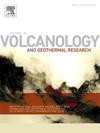Long-term thermo-fluid dynamic modeling of Solfatara hydrothermal system, Campi Flegrei caldera
IF 2.4
3区 地球科学
Q2 GEOSCIENCES, MULTIDISCIPLINARY
Journal of Volcanology and Geothermal Research
Pub Date : 2025-01-22
DOI:10.1016/j.jvolgeores.2025.108277
引用次数: 0
Abstract
Solfatara hydrothermal system lies within the active and densely populated volcanic area of the Campi Flegrei caldera; during bradyseismic crises, the Solfatara crater behaves as a deforming region with intense seismicity and gas emissions. Advancements on multiphysics modeling of this area can therefore provide insights into the relationship between the magmatic and hydrothermal systems of this high-risk caldera. In this work, we performed a 2D numerical modeling describing the long-term thermo-fluid dynamic processes arising beneath the Solfatara crater. This model is innovative since it simulates the evolution of thermal and fluid flow regimes from the system formation, i.e., 4500 yrs. ago, without a priori assumptions about the amount of deep hot CO2-rich fluid injections. We first collect geological information to define a more refined heterogeneous model integrating well data, rocks density, porosity, permeability, heat capacity, thermal conductivity, surface emissivity parameters and structural elements. We set a steady-state conductive temperature model and use the result as the initial condition for the transient analysis. Then, we performed time-dependent studies by coupling the heat transfer with the fluid flow laws, retrieving an imaging of the hydrothermal system in terms of temperature, density and fluids migration velocity distributions. Our results highlighted the generation of a buoyancy-driven convective cell beneath the Solfatara crater, with a gas zone extending between 1000 and 500 m b.s.l. We conclude by reiterating the importance of this model, which has to be used as a starting scenario for new studies on the evolution of geochemical and geophysical indicators of the Solfatara system.
Campi Flegrei火山口Solfatara热液系统的长期热流体动力学模拟
Solfatara热液系统位于Campi Flegrei火山口活跃且人口稠密的火山区内;在缓发地震危机期间,索尔法塔拉火山口表现为具有强烈地震活动和气体排放的变形区域。因此,该地区多物理场建模的进展可以为这个高风险火山口的岩浆系统和热液系统之间的关系提供见解。在这项工作中,我们进行了二维数值模拟,描述了在Solfatara陨石坑下产生的长期热流体动力学过程。这个模型是创新的,因为它模拟了从系统形成(即4500年)开始的热量和流体流动状态的演变。在没有对深部富含二氧化碳的热流体注入量进行先验假设的情况下,首先,我们收集地质信息,将井数据、岩石密度、孔隙度、渗透率、热容、导热系数、表面发射率参数和结构元素结合起来,定义一个更精细的非均质模型。我们建立了稳态导电温度模型,并将其结果作为暂态分析的初始条件。然后,我们通过耦合传热与流体流动规律进行了时间依赖性研究,检索了热液系统的温度、密度和流体迁移速度分布的成像。我们的结果强调了Solfatara陨石坑下浮力驱动的对流单元的产生,气体带延伸在1000到500 m b.s.l之间。我们最后重申了该模型的重要性,它必须作为Solfatara系统地球化学和地球物理指标演化新研究的起点。
本文章由计算机程序翻译,如有差异,请以英文原文为准。
求助全文
约1分钟内获得全文
求助全文
来源期刊
CiteScore
5.90
自引率
13.80%
发文量
183
审稿时长
19.7 weeks
期刊介绍:
An international research journal with focus on volcanic and geothermal processes and their impact on the environment and society.
Submission of papers covering the following aspects of volcanology and geothermal research are encouraged:
(1) Geological aspects of volcanic systems: volcano stratigraphy, structure and tectonic influence; eruptive history; evolution of volcanic landforms; eruption style and progress; dispersal patterns of lava and ash; analysis of real-time eruption observations.
(2) Geochemical and petrological aspects of volcanic rocks: magma genesis and evolution; crystallization; volatile compositions, solubility, and degassing; volcanic petrography and textural analysis.
(3) Hydrology, geochemistry and measurement of volcanic and hydrothermal fluids: volcanic gas emissions; fumaroles and springs; crater lakes; hydrothermal mineralization.
(4) Geophysical aspects of volcanic systems: physical properties of volcanic rocks and magmas; heat flow studies; volcano seismology, geodesy and remote sensing.
(5) Computational modeling and experimental simulation of magmatic and hydrothermal processes: eruption dynamics; magma transport and storage; plume dynamics and ash dispersal; lava flow dynamics; hydrothermal fluid flow; thermodynamics of aqueous fluids and melts.
(6) Volcano hazard and risk research: hazard zonation methodology, development of forecasting tools; assessment techniques for vulnerability and impact.

 求助内容:
求助内容: 应助结果提醒方式:
应助结果提醒方式:


